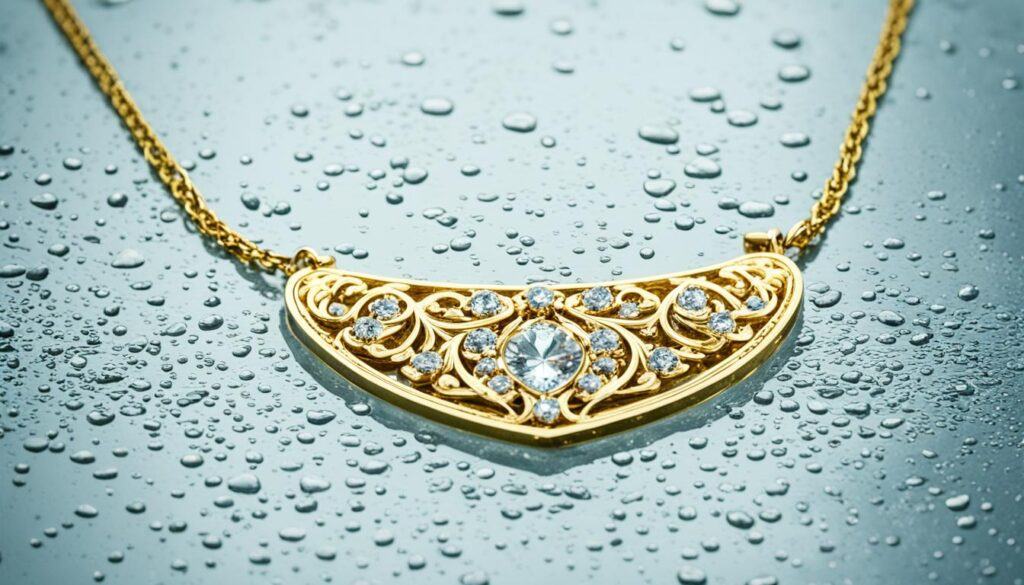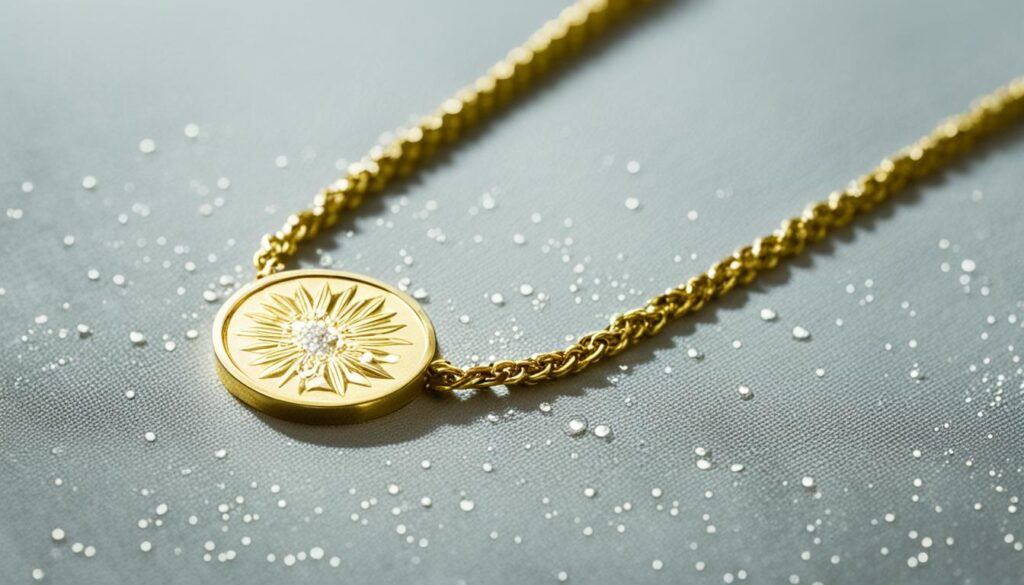Hello, I’m here to answer a common question: is gold plated waterproof? Let’s dive into the details and find out.
Gold plated jewelry is a popular choice for its luxurious appearance. However, when it comes to water resistance, gold plated items have their limitations. The gold plating process involves bonding a layer of gold to a base metal using a chemical solution and an electric current. While this process creates a beautiful finish, it is not designed to withstand prolonged exposure to water.
If you own gold plated jewelry, it is important to avoid wearing it while swimming or showering. Prolonged exposure to water can tarnish and wear down the gold plating over time. To maintain the longevity of your gold plated items, it is recommended to wipe them after each use and avoid contact with lotions, makeup, and perfumes until after they are put on.
Key Takeaways:
- Gold plated jewelry is not waterproof.
- Prolonged exposure to water can tarnish and wear down the gold plating.
- Avoid wearing gold plated jewelry while swimming or showering.
- Wipe gold plated items after each use and avoid contact with lotions, makeup, and perfumes until after they are put on.
- Proper care and maintenance are essential to extend the lifespan of gold plated jewelry.
Types of Gold Jewelry: Gold Plated, Gold Filled, Gold Vermeil, Solid Gold
When it comes to gold jewelry, there are several types available in the market, each with its own unique characteristics and properties. Understanding the differences between these types can help you make an informed choice when shopping for gold jewelry. The four main types of gold jewelry are gold plated, gold filled, gold vermeil, and solid gold.
- Gold Plated: Gold plated jewelry consists of a base metal, such as brass or copper, which is coated with a layer of gold. The gold plating is bonded to the base metal using a chemical solution and an electric current. While gold plated jewelry offers an attractive and affordable option, the gold coating is thin and can wear off over time, especially with frequent contact with water or harsh chemicals.
- Gold Filled: Gold filled jewelry has a solid core made of brass or copper, over which a thick layer of gold is mechanically bonded. This layer of gold is much thicker than the gold plating in gold plated jewelry. As a result, gold filled jewelry is more durable and has a longer lifespan compared to gold plated pieces. It is also more resistant to tarnishing and can withstand occasional exposure to water.
- Gold Vermeil: Gold vermeil jewelry is made by plating a layer of gold on top of 925 sterling silver. To be classified as vermeil, the gold plating must be at least 2.5 microns thick. This type of jewelry offers the elegance of gold at a more affordable price compared to solid gold. However, the silver base metal makes it less durable and more prone to tarnishing compared to gold filled or solid gold jewelry.
- Solid Gold: Solid gold jewelry is made entirely of gold, with no other metals added. The purity of solid gold is measured in karats (K), with 24K gold being the purest form. Solid gold jewelry is highly durable and has a timeless appeal. It is also the most expensive type of gold jewelry due to its purity.
Each type of gold jewelry has its own advantages and considerations. While gold plated and gold vermeil jewelry offer affordability and style, they are less durable and may require more maintenance. Gold filled jewelry is a good balance between affordability and durability, making it a popular choice among shoppers. Solid gold jewelry, on the other hand, offers the highest level of durability and value, making it a long-term investment.
Understanding the differences between these types of gold jewelry can help you choose the one that best suits your budget, style, and durability needs. Whether you opt for the affordability of gold plated jewelry, the durability of gold filled pieces, the elegance of gold vermeil, or the timeless appeal of solid gold, there is a type of gold jewelry out there for everyone.
Durability and Water Resistance of Gold Plated Jewelry
Gold plated jewelry is known for its exquisite appearance, but it’s important to understand its limitations when it comes to durability and water resistance. While gold plating adds a touch of luxury to your accessories, it is less durable compared to other types of gold jewelry and not completely water-resistant.
The durability of gold plated jewelry can vary depending on factors such as the thickness of the gold layer and the quality of the plating process. On average, the gold plating can start to tarnish and wear down after approximately two years of regular use.
To maintain the longevity of your gold plated jewelry, it is important to follow some care tips. After each use, gently wipe the jewelry with a soft cloth to remove any dirt or oils that may have accumulated. Avoid exposing your gold plated items to water, as prolonged exposure can cause the gold plating to deteriorate.
While it’s best to avoid wearing gold plated jewelry while swimming or showering, occasional exposure to water is generally fine as long as you dry the jewelry thoroughly afterwards. Remember to remove your gold plated jewelry before applying lotions, makeup, or perfumes, as these substances can also degrade the gold plating over time.
Tip: To enhance the longevity of your gold plated jewelry, store it separately from other items to prevent scratching and avoid exposing it to harsh chemicals or high humidity levels.

While gold plated jewelry may not have the same level of durability and water resistance as solid gold or other types of gold jewelry, proper care and maintenance can help prolong its lifespan and keep it looking its best.
| Durability | Water Resistance |
|---|---|
| Less durable compared to other types of gold jewelry | Not completely water-resistant |
| The gold plating can tarnish and wear down after approximately two years of regular use | Avoid prolonged exposure to water |
| Proper care and maintenance can help prolong its lifespan | Occasional exposure to water is generally fine, but thorough drying is necessary |
Advantages of Waterproof Gold Plated Jewelry
While gold plated jewelry is not completely waterproof, it does offer several advantages in terms of water resistance.

The gold plating on jewelry creates a protective layer on the base metal, making it more resistant to water compared to non-plated jewelry.
Water-resistant gold plated jewelry can withstand occasional exposure to water without immediate damage.
For example, wearing gold plated earrings while washing hands or getting caught in a light rain shower should not cause the jewelry to tarnish or deteriorate.
However, it is important to note that prolonged exposure to water, such as wearing gold plated jewelry while swimming or showering, can still cause the gold plating to wear down over time.
To maintain the durability of water-resistant gold plated jewelry, it is recommended to avoid prolonged exposure to water and to dry the jewelry thoroughly after any contact with moisture.
Care Tips for Gold Plated Jewelry
To prolong the lifespan of gold plated jewelry, it is important to follow proper care tips. Taking good care of your gold plated items will help maintain their appearance and durability over time. Here are some essential care tips to keep in mind:
1. Wipe with a Soft Cloth
After each use, gently wipe your gold plated jewelry with a soft cloth to remove any dirt, oils, or residue. This will help prevent buildup and keep your jewelry looking its best.
2. Soak in Warm, Soapy Water
Periodically, you can soak your gold plated jewelry in warm, soapy water for a few minutes to remove any stubborn grime or buildup. Use a mild, gentle soap and avoid harsh chemicals that can damage the gold plating.
3. Thoroughly Dry the Jewelry
After cleaning or whenever your gold plated jewelry comes in contact with water, it is crucial to thoroughly dry it. Use a clean, soft cloth to remove any moisture and ensure that no water droplets remain trapped, as they can lead to tarnish or corrosion.
4. Avoid Contact with Lotions, Makeup, and Perfumes
Before putting on your gold plated jewelry, make sure to apply any lotions, makeup, or perfumes first. These products can contain chemicals that can potentially damage the gold plating. Wait for them to fully absorb or dry before wearing your jewelry.
5. Keep Away from Water and Humidity
While gold plated jewelry can withstand occasional exposure to water, it is best to avoid prolonged contact with water, especially in activities like swimming or showering. Additionally, high humidity levels can accelerate tarnishing, so store your jewelry in a dry environment.
6. Store Separately
To prevent scratching and tangling, store your gold plated jewelry separately from other items, such as in a soft pouch or compartmentalized jewelry box. This will help preserve its shine and prevent any potential damage.
| Care Tips for Gold Plated Jewelry | |
|---|---|
| Wipe with a soft cloth after each use | |
| Soak in warm, soapy water to remove buildup | |
| Thoroughly dry the jewelry to prevent moisture damage | |
| Avoid contact with lotions, makeup, and perfumes | |
| Keep away from prolonged water exposure and high humidity | |
| Store gold plated jewelry separately to prevent scratching |
By following these care tips, you can enjoy your gold plated jewelry for longer and maintain its beautiful appearance. Remember to treat your gold plated items with care and avoid exposing them to substances or activities that can potentially damage the gold plating.

Understanding Waterproof and Water-Resistant Jewelry
When it comes to jewelry, understanding the difference between waterproof and water-resistant is essential. While these terms may seem interchangeable, they represent distinct characteristics that determine a piece’s resistance to water exposure.
Waterproof jewelry is designed to be impervious to water, allowing it to withstand prolonged exposure without suffering any damage. This type of jewelry is perfect for activities like swimming, diving, or even taking a shower, as it remains unaffected by water.
On the other hand, water-resistant jewelry can resist water penetration to a certain degree but is not completely impervious. This means that while it can withstand occasional exposure to water without immediate damage, prolonged water exposure may still lead to deterioration.
Gold plated jewelry falls under the category of water-resistant jewelry. It features a layer of gold bonded to a base metal, providing an attractive appearance while still offering some level of water resistance. Although gold plated jewelry can withstand occasional exposure to water, it is important to note that prolonged exposure may cause the gold plating to wear down over time.
To illustrate the difference between waterproof and water-resistant jewelry, let’s take a closer look at the characteristics of each:
| Characteristics | Waterproof Jewelry | Water-Resistant Jewelry |
|---|---|---|
| Resistance to Prolonged Water Exposure | Impervious to water | Can withstand occasional exposure, but prolonged exposure may cause damage |
| Activities | Perfect for swimming, diving, and showering | Suitable for everyday wear and occasional exposure to water |
| Maintenance | Requires minimal maintenance | May require careful cleaning and drying after water exposure |
| Durability | Highly durable | Less durable compared to waterproof jewelry |
Note: The table above provides a comparison between waterproof and water-resistant jewelry in terms of their characteristics. It is important to remember that the water resistance of gold plated jewelry, as a type of water-resistant jewelry, may vary depending on the quality of the plating and the care taken to maintain it.
Understanding the distinction between waterproof and water-resistant jewelry can help you make informed choices about the type of jewelry that suits your needs and lifestyle. Whether it’s waterproof jewelry for water-intensive activities or water-resistant jewelry for everyday wear, considering the water resistance of your jewelry ensures its longevity and enhances your overall experience.
Factors Affecting the Durability of Gold Jewelry in Water
Several factors can impact the durability of gold jewelry when exposed to water. Understanding these factors is crucial for maintaining the longevity and quality of your gold pieces.
One significant factor is the presence of harsh chemicals, such as chlorine in swimming pools and bleach. These chemicals can cause damage to gold jewelry, including gold plated items. Prolonged exposure to chlorine can lead to discoloration, tarnishing, and even degradation of the gold plating.
High humidity levels also play a role in affecting the durability of gold in water. Moisture in the air can accelerate the tarnishing process, causing gold jewelry to lose its shine and luster over time.
Additionally, certain activities can increase the risk of losing gold jewelry in water. Engaging in exercise or participating in water sports can lead to movements and temperature changes that affect the fit of rings and clasps. This can result in accidental loss or damage to your jewelry.
To protect your gold jewelry from the factors that reduce its durability in water, it is essential to take preventive measures. Avoid wearing gold jewelry while swimming, showering, or engaging in water-related activities. When not in use, store your gold pieces in a cool and dry place to minimize exposure to moisture.
Regular cleaning and maintenance are also crucial. Use a soft cloth to polish your gold jewelry and remove any dirt or residue. Avoid using harsh chemicals or abrasive materials that could scratch or damage the surface. Following these care tips can help preserve the beauty and durability of your gold jewelry.

| Factors | Effects | ||
|---|---|---|---|
| Harsh Chemicals | – Discoloration | – Tarnishing | – Degradation of gold plating |
| High Humidity | – Accelerated tarnishing process | – Loss of shine and luster | |
| Physical Activity | – Risk of accidental loss | – Damage to rings and clasps |
Protecting your gold jewelry from these factors will help maintain its durability and ensure it remains a cherished piece for years to come.
Solid Gold vs Gold Plated: Waterproof Comparison
When it comes to the waterproofness of jewelry, there are significant differences between solid gold and gold plated pieces. Solid gold jewelry, made of 24K gold, is completely waterproof and can be confidently worn in water without any concerns. The natural properties of solid gold make it resistant to tarnishing and corrosion, allowing it to withstand prolonged exposure to water without any damage.
On the other hand, gold plated jewelry is only water-resistant to a certain extent. While the gold plating provides a layer of protection on the surface of the jewelry, it is not designed to withstand extended periods of water exposure. Over time, prolonged contact with water can cause the gold plating to tarnish and wear down, eventually leading to a loss of its luster and appearance.
For those seeking waterproof jewelry, solid gold is undoubtedly the superior choice. Its durability and resistance to water make it a perfect option for everyday wear, whether you’re swimming, showering, or enjoying other water-based activities. Solid gold jewelry maintains its beauty and value even with constant contact with water.
To visually compare the waterproofness of solid gold and gold plated jewelry, refer to the table below:
| Solid Gold | Gold Plated | |
|---|---|---|
| Waterproofness | Completely waterproof | Water-resistant, but not completely waterproof |
| Longevity | Durable with no tarnishing or wearing down | Can tarnish and wear down with prolonged water exposure |
| Recommended Use | Safe for swimming, showering, and water-based activities | Avoid exposing to water for extended periods |
As the table and image above demonstrate, solid gold jewelry offers superior waterproofness and durability compared to gold plated jewelry. Investing in solid gold pieces ensures long-lasting beauty and resilience, while gold plated jewelry requires more cautious care to maintain its appearance over time.
Conclusion
In conclusion, gold plated jewelry is not completely waterproof, but it can withstand occasional exposure to water. The gold plating provides a protective layer on the base metal, making it more resistant to water compared to non-plated jewelry. However, prolonged water exposure can cause the gold plating to deteriorate over time.
If waterproofness is a priority for you, it is recommended to choose solid gold jewelry. Solid gold items, made of 24K gold, are completely waterproof and can be worn in water without any concerns. Solid gold jewelry offers the highest level of durability and water resistance.
To maintain the longevity of gold plated jewelry, it is important to follow proper care and maintenance practices. After each use, wipe the jewelry with a soft cloth to remove any dirt or debris. Avoid exposing gold plated items to water, lotions, makeup, and perfumes. Storing the jewelry separately from other items can help prevent scratching. By taking these steps, you can extend the lifespan of your gold plated jewelry and keep it looking its best.
FAQ
Is gold plated jewelry waterproof?
No, gold plated jewelry is not waterproof. While the gold plating provides a beautiful appearance, it is not designed to withstand prolonged exposure to water. Gold plated jewelry should not be worn while swimming or showering, as it may tarnish and wear down the gold plating over time.
What are the types of gold jewelry available in the market?
There are various types of gold jewelry available in the market, including gold plated, gold filled, gold vermeil, and solid gold.
How durable is gold plated jewelry in water?
Gold plated jewelry is less durable and not water-resistant. The gold plating on the jewelry can start to tarnish and wear down after approximately two years of use. Prolonged exposure to water can cause the gold plating to deteriorate over time.
What are the advantages of waterproof gold plated jewelry?
While gold plated jewelry is not completely waterproof, it can still offer some advantages in terms of water resistance. The gold plating provides a protective layer on the base metal, making it more resistant to water compared to non-plated jewelry. Water-resistant gold plated jewelry can withstand occasional exposure to water without immediate damage.
How should I care for gold plated jewelry?
To maintain the longevity and appearance of gold plated jewelry, it is recommended to wipe them after each use and avoid contact with water, lotions, makeup, and perfumes. It is also advisable to store the jewelry separately to prevent scratching.
What is the difference between waterproof and water-resistant jewelry?
Waterproof jewelry is impervious to water and can withstand prolonged water exposure without damage. Water-resistant jewelry, like gold plated jewelry, can resist water penetration to a certain degree but is not completely impervious.
What factors affect the durability of gold jewelry in water?
Exposure to harsh chemicals, high humidity levels, and activities like exercise and water sports can affect the durability of gold jewelry in water.
How does solid gold compare to gold plated in terms of waterproofness?
Solid gold jewelry is completely waterproof, while gold plated jewelry is only water-resistant. Solid gold items, made of 24K gold, can be worn in water without any concerns. Gold plated jewelry should not be exposed to water for extended periods as the gold plating can tarnish and wear down.



